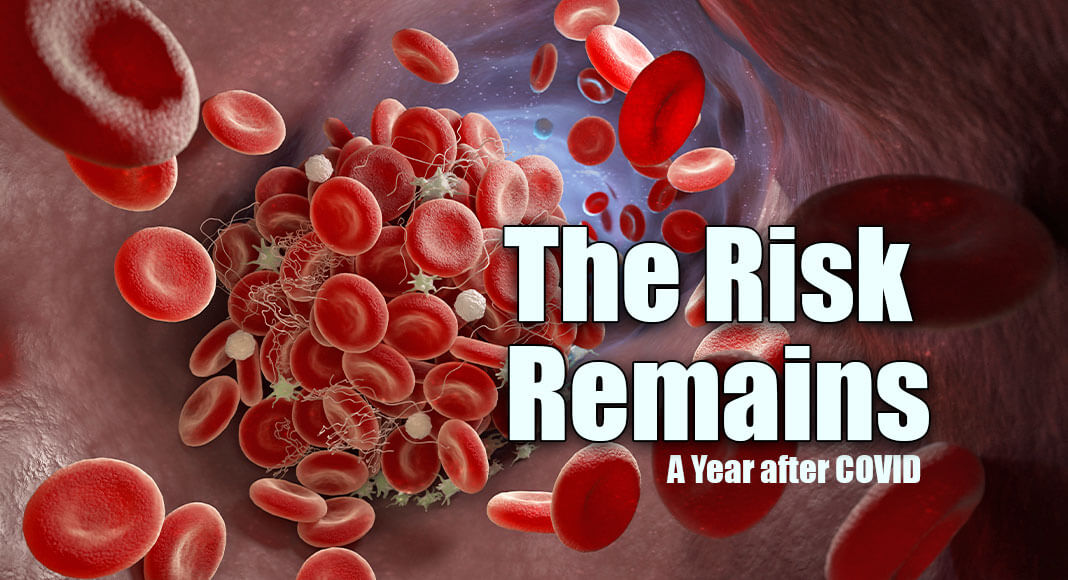
Mega Doctor News
By Michael Merschel, American Heart Association News
People who got COVID-19 had a higher risk of dangerous blood clots for close to a year later, according to a large new study on the aftereffects of a SARS-CoV-2 infection during the period before vaccines became available.
As seen in previous studies, COVID-19 was linked to a sharply increased risk of blood clot-related issues – including heart attack and stroke – immediately after diagnosis compared to people who never had COVID-19. But the new study found that risk remained higher for some problems up to 49 weeks later.
At that point, the risk of deep vein thrombosis – clots that form in large veins – was nearly double in people who’d had COVID-19 compared to those who had not, according to the study published Monday in the American Heart Association journal Circulation.
The study used data collected anonymously from 48 million people – nearly every adult in England and Wales – in Great Britain’s National Health System from January 2020 until the day before COVID-19 vaccines were made available that December.
The findings reinforce the message that for people who have cardiovascular conditions, “taking established preventative medications and managing your risk factors is even more important now than it was before the pandemic,” said Jonathan Sterne, the study’s senior author and a professor of medical statistics and epidemiology at England’s University of Bristol.
The study looked at results from 1.4 million diagnoses of COVID-19, which researchers said led to an estimated 10,500 additional cases of clot-related problems.
Extensive data collection and linkage in effect across Great Britain enabled researchers to crunch the numbers, Sterne said.
Researchers found that the first week after a COVID-19 diagnosis, the risk of an arterial blood clot – the kind that could cause a heart attack or ischemic stroke by blocking blood flow to the heart or brain – was nearly 22 times higher than in someone without COVID-19. That risk dropped sharply, to less than four times higher, in the second week.
“Between 27 and 49 weeks, there is an approximately 30% increased risk for arterial clots, Sterne said. “But the elevation is greater for longer” for clots in veins, which include deep vein thrombosis and pulmonary embolism, when a clot travels to the lungs.
In the first week after a COVID-19 diagnosis, the risk of such venous problems was 33 times higher. By the third and fourth weeks after diagnosis, the risk was still about eight times higher. And between 27 and 49 weeks later, the risk was still 1.8 times higher than in somebody who had never had COVID-19.
“I do think that that is a new element to the story – that the risk is not only around the time of the acute COVID infection,” said Dr. Karen Furie, chief of neurology at Rhode Island Hospital and chair of neurology at Brown University’s Warren Alpert Medical School in Providence. The higher risk of clots in veins than in arteries also got her attention. Furie was not involved in the study.
Elevated risks persisted no matter whether someone was hospitalized for COVID-19, although risks were greater in people who were hospitalized. The study also showed that clot risks were higher in Black and Asian people.
Overall, however, clots were rare. The overall increase in risk of developing an arterial clot in the 49 weeks after a COVID-19 diagnosis was 0.5%. For a venous clot, the risk was 0.25%. After 1.4 million COVID-19 diagnoses, that corresponds to about 7,200 additional heart attacks or strokes, and 3,500 additional cases of pulmonary embolism, deep vein thrombosis or other venous problems.
Furie said the size of the study made it “extremely powerful.” But the authors acknowledged they might have missed some cases of COVID-19 before testing became widely available, or vascular events if people avoided hospitals early in the pandemic.
Although several variants of the coronavirus that causes COVID-19 have emerged since the time of the study, Furie said the information remains relevant. The study confirms “that infection with COVID, and other viruses for that matter, do have an inflammatory effect that can stimulate thrombotic events,” she said.
Given that risks can be elevated for close to a year, Furie said people should be screened and monitored for any evidence of risk factors that could be mitigated by preventive therapies, such as blood-thinning medications.
Treatment protocols that were emerging at the time of the study have evolved in that direction, she said, but the new findings suggest problems might need to be managed more aggressively. “I think that this puts a new perspective on that period of subsequent risk.”
Sterne said the findings are likely to apply broadly outside England and Wales. A follow-up study is looking at the period from June 2021 onward, when the delta and omicron variants of the coronavirus became dominant and when many people had been vaccinated. The Centers for Disease Control and Prevention recommends people stay up to date with COVID-19 vaccination for their age group to protect against serious illness, hospitalization and death.
For now, Sterne said, the study shows that if someone had COVID-19, “then they should be talking with their physicians about managing their cardiovascular risk, which is likely to be increased for some level of time.”Editor’s note: Because of the rapidly evolving events surrounding the coronavirus, the facts and advice presented in this story may have changed since publication. Visit Heart.org for the latest coverage, and check with the Centers for Disease Control and Prevention and local health officials for the most recent guidance










